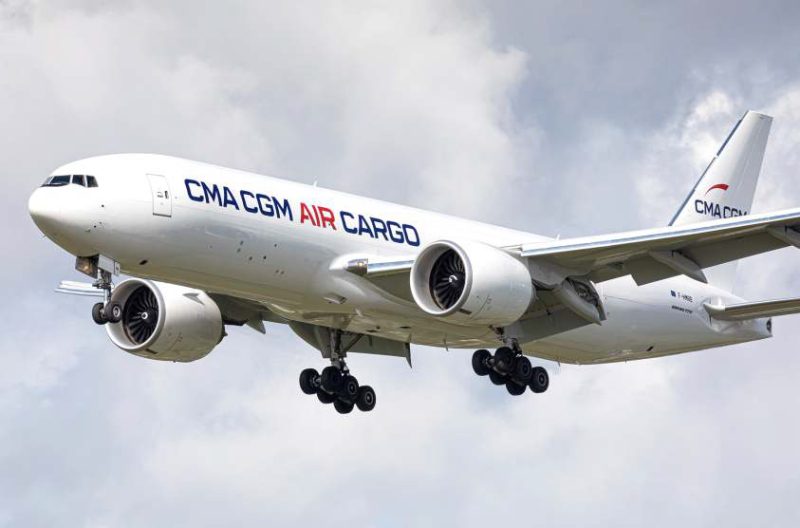From Concept to Delivery: How CMA CGM Air Cargo Tailors Solutions for Specialized Cargo
“There is no ‘one size fits all’, in this respect, we are a boutique airline, looking at each special shipment individually when it comes to ensuring we are meeting our regulatory and legal obligations. Our combined teams have tremendous expertise and years of air cargo knowledge.”

In the air cargo industry, every cargo matters. But there are also shipments that need unique requirements for their safe handling, storage, or transportation.
These are categorized as “special cargo”. This covers a diverse range of items, such as fine art, jewelry, pharmaceuticals, sensitive equipment, dangerous goods, live animals and even live stage props for entertainment events. Overall, expertise in specialized cargo plays a vital role in ensuring its safe, efficient, and compliant transportation. The unique nature of these goods necessitates specialized care and attention, often involving additional security measures, temperature controls, or custom-designed containers.
The global Perishable Goods Transportation market size was valued at USD 4211.82 million in 2021 and is expected to expand at a CAGR of 8.04% during the forecast period, reaching USD 6696.81 million by 2027 (precision reports).
In this exclusive interview with Air Cargo Update, Damien Mazaudier, CEO of CMA CGM Air Cargo, discusses the unique challenges and considerations involved in transporting specialized cargo.
Mazaudier also explores the innovative approaches and technologies CMA CGM Air Cargo employs to meet the demands of modern air freight logistics, while also prioritizing sustainability and environmental responsibility.
Specialized Cargo handling types
Mazaudier explains that since the very first days of CCAC, has been transporting many special and unique goods on their aircraft. These include:
Aircraft engines and some big aircraft parts.
“The dimensions are or can be an issue to handle, from delivery in the warehouse to handling it through the aircraft door. The weight also could be a challenge when positioning it in the aircraft. Just like dangerous goods could be a topic when moving this kind of cargo. The expertise of our teams and load masters’ do make the difference. They are in the warehouse and by the aircraft assisting, guiding and supervising the loading, ensuring that the shipment is handled with care as per the latest industry standards.”
Humanitarian relief goods.
“Thanks to our reactivity and ability to engage crew and aircraft very rapidly, we have done numerous charter flights where speed is of the essence, bringing relief goods to disaster areas. Our expert teams work with the customer right from the very beginning at quotation time, till loading and unloading under the supervision of our load masters. We can arrange everything; all permits in order to enable those flights in record time.”
Perishable and live animals.
“Our ground processes, qualified staff and the partnership with our best-in class handling agents ensure optimal handling of those sensitive products. Well defined ground processes and worldwide consistent implementation of those processes are crucial for the product integrity and the well-being of the animals. Of course, we adhere to the strictest industry standards”.
Temperature controlled goods.
“We perfectly understand the necessity to maintain product integrity during the transportation of temperature-controlled goods. We work as per GDP principles. Our staff are perfectly trained, our processed designed around GDP requirements and we work with certified GHA partners to ensure that we can keep our customer promise. All those actions are strictly supervised by our expert teams, whether at the hub or in the outstations. When customers entrust us with those shipments, we ensure that we give them peace of mind.”
Adhering to IATA Dangerous Goods Regulations
Air cargo carries more than 1.25 million dangerous goods every year. IATA notes that the number of dangerous goods will increase significantly with the air cargo forecast to grow at 4.9% per year for the next five years.
Safety regulations are essential when shipping dangerous goods by air. IATA identifies risks and works closely with ICAO to update regulations. This provides stakeholders with the latest guidelines for handling and shipping dangerous goods.
“As a freighter operator, we are transporting hazardous materials from simple consumer goods (like perfume) to lithium batteries, in full accordance with the IATA Dangerous Goods Regulations
and all other international/local regulations (including ICAO). We understand the importance to transport those goods in a safe and consistent way across our network,” explains Mazaudier.
“As an airline, we have a dedicated DG responsible person ensuring that we adhere to the latest and strictest industry and local regulations. All our staff (on the ground and in the air) are being trained in the specificities of handling dangerous goods. As a freighter airline, we have more opportunities to transport DG, therefore special focus is placed on ensuring that we stick to our processes. We have received all DG licenses from our French Civil Aviation Authority and are certified to transport and handle DG all over our network. Our partner GHAs are perfectly trained to handle dangerous goods. We are also able to obtain exemptions and approvals to transport certain more delicate materials,” he added.
Handling Agents’ Partnership
According to Mazaudier, CMA CGM Air Cargo has partnered with handling agents who are providing the requested equipment in case of special shipment.
For vulnerable shipments, dedicated storage is being arranged, with close monitoring.
“For pharmaceutical shipments we rely on our hub GHA WFS and their highly sophisticated pharma center, equipped with appropriate temperature-controlled storage areas and fully CEIV-pharma compliant,” he said.
According to him, equipment and facilities’ efficient processes and trained expert teams are key to ensuring safe and reliable consistent transportation of special cargo.
“Understanding transportation pain-points is key. Our sales, ground ops and load master teams are always very close to all supply chain stakeholders to discuss optimal transportation solutions. We believe in tailor-made solutions and cocreation to fully exploit the capabilities of our freight fleet and meet the needs of our customers,” he noted.
Implementing Stringent Security Protocols
Most specialized cargo shipments are valuable or delicate, requiring expert handling to ensure their safety during transportation.
CMA CGM Air Cargo implements a variety of strategies and protocols to safeguard these goods throughout the journey.
From meticulous planning and secure packaging to advanced tracking systems and trained personnel, every precaution is taken to minimize risks and protect the integrity of the cargo.
“When required, we work with all actors of the supply chain to ensure the right measures are in place for safe and secure cargo transportation. For example: Sensitive cargo is stored in dedicated areas, under close CCTV monitoring. Our RFS providers are all using GPS tracking of their trucks, therefore knowing in real time where the cargo is.
“We allow approved tracking devices on our aircraft: whether they are active or passive, those tracking devices can record temperature, shock, light exposure, and we can react fast in case of irregularity.
“We should also look at how to leverage technology (IoT, block chain) to reinforce security/safety around the transportation of cargo, together with all the other actors around the supply chain (shippers, RFS providers, GHAs, authorities).
“Packaging is also crucial for a safe and secure movement of cargo: this is the responsibility of the shippers and we rely on their professionalism to ensure this is meeting the latest standards,” said Mazaudier.
Challenges Faced
Mazaudier also shared one of his most challenging experiences in the industry.
“We had this one engine shipment with dimensions “ok” on paper but was not possible to load. Through dialogue with the shipper, our load masters and ground ops teams found the solution by removing a part of the engine so that it could go through the door and be loaded in the aircraft. Our teams were evaluating the best solution guaranteeing safety of the shipment as well as the aircraft,” he said.
With the ever-increasing demand for efficient air cargo transport, the importance of packaging and labelling solutions in safeguarding fragile items cannot be overlooked.
“The shipper is the key and fully in charge of the packaging and labelling of any special goods. Our handling agents will check at acceptance that the packaging is in good state, that proper labelling such as fragile, perishable, temperature or any hazardous nature is well on the boxes delivered. Having trained staff and working with best-in-class GHAs is key to success,” he said.
Any mishandling of hazardous goods can have severe consequences. Labelling plays a crucial role in identifying the potential risks associated with these materials.
Clear and standardized labels help workers, emergency responders, and the public quickly recognize the hazards present, enabling them to take appropriate precautions and actions to prevent accidents.
“Very special goods are usually delivered at the last minute, ensuring smooth acceptance, appropriate ground handling and loading in the aircraft. Pharma products are stored in appropriate temperature controlled areas. And vulnerable goods are stored in dedicated areas with close supervision,” said Mazaudier.
“Storage is actually a GHA responsibility. So, we ensure proper dialogue and quality monitoring with our ground partners.”
International Logistics Process
The process of international logistics involves the transport of finished products along an international supply chain.
It involves cross-border shipping as well as international distribution to deliver goods efficiently to users around the world.
While transporting fragile items across borders, various factors come into play that can affect the safety of the shipment. The mode of transportation, packaging materials used, handling procedures, and the distance the items need to travel all play a significant role in ensuring the safe delivery of fragile goods.
The mode of transportation, whether by air, sea, or land, can impact the level of jostling and vibrations the items are exposed to during transit.
The quality of packaging materials, such as cushioning materials and sturdy boxes, can make a difference in protecting fragile items from impact and pressure.
The handling procedures at customs checkpoints and during loading and unloading can also impact the safety of fragile items during transportation.
“Indeed, regulations and compliance topics are getting more and more complex and ever-changing. Our expert teams are keeping up to date with the latest rules and regulations,” said Mazaudier.
“We also work with a network of agents for country specific regulations. Our connections with authorities and civil aviation worldwide allow us to be aware of the latest developments. Finally, as we are pa of CMA CGM Group, a global player in sea, land, air and logistics solutions, so we also have access to a lot of internal information regarding expos and trade: we can always rely on our shipping colleagues to help us in case of questions,” he added.
No ‘One Size Fits All’ Approach
A necessary step in ensuring the safety of specialized cargo shipments is classifying the materials being transported. Hazardous materials are categorized based on their potential risks, such as flammability, toxicity, and reactivity.
Experts must accurately label and document these materials to determine the appropriate handling procedures and emergency response protocols.
“There is no ‘one size fits all’ on this topic, in this respect we are a boutique airline, looking at each special shipment individually when it comes to ensuring we are meeting our regulatory and legal obligations. Our combined teams have tremendous expertise and years of air cargo knowledge,” said Mazaudier.
“We also leverage CMA CGM Group resources, like for instance its vast and recognized expertise on compliance topics. Our processes are well defined, ensuring allregulatory and legal obligations are covered,” he added.
Focus on Sustainability
The CMA CGM Group is committed to achieving Net Zero Carbon by 2050 across all its activities, including air freight
activities.
“To support our ambition to reduce the carbon footprint of our air operations, we are working on three main areas: operations optimization, aircraft modernization, and the use of sustainable fuels.
“Our air operations are making significant optimization efforts, particularly by leveraging artificial intelligence (SkyBreathe® software) to analyze extensive data from each flight (collected from black box data recorders, weather, and air traffic) to optimize flight plans and maneuvers both in the air and on the ground, and thus reduce fuel consumption.”
Furthermore, CMA CGM Air Cargo will be the launch company for the A350F, the most efficient air freight model on the market. Thanks to its optimized fuselage, the use of lighter composite materials, and its enhanced engine, the A350F will emit an average of 20% less CO2 equivalent than its current equivalent, the B777.
CMA CGM Air Cargo is also gradually integrating sustainable aviation fuels (SAF) into its energy mix.














